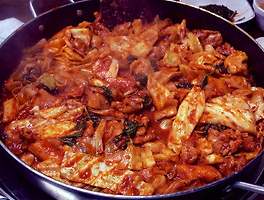CNN travel에서 선정한 대한민국의 가장맛있는 음식 10선입니다. CNN에서 제공하는 뉴스는 나도 모르는것이 종종나타납니다. 한국인이 보는 시각에서 조금 다르게 보는 외국인의 시각으로 생각하는 기회가 됩니다. 어떤 내용이 있는지 알아보도록 하겠습니다.
구글번역기로 돌려서 대충 해석하는 느낌, 매끄럽게 문장이 완성되지 않는 한계를 가지고 있는것을 고려해서 봐주시기 바랍니다.
여기에서 소개하는 음식을 보면 너무나 대중적인 음식을 소개하고 있다. 하지만 제주도 향토음식인 맘국(모자반국)이 리스트에 올라와서 놀라고, 불고기가 없어서 놀랍다.
1. 묵은지
2. 닭갈비
3. 칼국수
4. 선지국밥
5. 꼼장어
6. 진주 비빕밥
7. 곰탕
8. 맘국
9. 콩나물 국밥
10. 낚지 볶음
이제 어떤내용인지 알아보도록 하겠다.
10 of South Korea's most delicious dishes / 대한민국의 가장맛있는 음식 10선입니다
(CNN) — Graham Holliday has made a career out of eating. The author of "Eating Viet Nam" recently published a new book, this time chronicling his culinary adventures through South Korea.
"Eating Korea: Reports on a Culinary Renaissance" explores the country's rich food history and evolving contemporary culinary scene.
Holliday shares 10 of his favorite Korean foods with CNN Travel -- covering everything from 3-year-old kimchi in Seoul to Busan's unusual type of bibimbap -- and offers a few tips on where to find them.
그레이엄 할러데이 (Graham Holliday) "먹는 베트남"의 저자는 최근에 새로운 책을 출판했다. 이번에는 한국을 통해 요리의 모험을 기록했다.
"먹는 한국 : 요리 르네상스 보고서"는 한국의 풍요로운 음식 역사와 진화하는 현대 요리 현장을 탐구합니다.
홀리데이 (Holliday)는 자신이 좋아하는 한국 음식 10 점을 CNN Travel과 공유한다. 서울의 3 살 김치에서부터 비범 한 비빔밥에 이르기까지 모든 것들을 다룬다.
1. Mugeunji
Hanokjib Kimchi-jjim, in the Seodaemun district of Seoul, is minimally decorated, aside from framed certificates, awards, news clippings, menus and pictures -- all pinned haphazardly to the wall.
The restaurant serves one thing: kimchi.
Usually made from cabbage and radish, kimchi that has fermented for six months or more is known as mugeunji and the mugeunji at this place is an exquisite 3 years old. A thick, sour, garlic-laced miasma greets you as you enter the traditional Korean-style house.
The room shudders with the smell, as a long, bloody rag of kimchi spread out like a dead octopus on an oval plate is placed on your table.
Hanokjib Kimchi-jjim, 178 Naengcheon-dong, Seodaemun-gu, Seoul, South Korea; +82 02 362 8653
1. 무근지
서울 서대문 지구에있는 한옥집 김치 찜은 액자 인증, 수상 경력, 뉴스 정리, 메뉴 및 그림 등을 제외하고는 최소한으로 꾸며져있다. 모든 것은 우연히 벽에 고정되어있다.
레스토랑은 김치를 제공합니다.
보통 양배추로 만든 것으로, 6 개월 이상 발효시킨 김치는 무근 지라고하며이 곳의 무근지는 3 세가 절묘합니다. 두껍고 사워지고 마늘이 빽빽한 이마가 전통적인 한국식 집에 들어서 자 여러분을 반깁니다.
방이 오랫동안 피 묻은 김치의 넝마가 타원형 접시에 죽은 문어처럼 펼쳐져있는 것처럼 냄새를 떨며 테이블 위에 놓습니다.
한국 서울 서대문구 자연천동 178 한옥집 김치 찜질 +82 02 362 8653
2. Dak galbi
Dak galbi is a stir-fried chicken dish from the northeastern city of Chuncheon.
Cooked on a large, round hot plate that's built into the table, the dish includes cabbage, rice cakes, onions, coarsely chopped leeks and sweet potatoes -- bathed in a hot, slightly sweet sauce made of red pepper paste, soy sauce and turmeric.
Dak galbi is special -- it's a mess, a mistake that works.
After it has been cooked and stirred, it looks like a building site where everything Korean that's edible got dumped inside, turned upside down and rattled about.
Dak galbi is a glorious dish and Chuncheon is the place to eat it.
1.5 Dak Galbi, 77 Human-ro, Hupyeong 3 (sam)-dong, Chuncheon, South Korea; +82 33-253-8635
2. 닭 갈비
닭 갈비는 북동부 춘천에서 볶은 닭 요리입니다.
식탁에 내장 된 커다란 둥근 핫 플레이트에서 요리 한이 요리는 양배추, 떡, 양파, 굵은 파와 파, 고구마를 포함하며 고추장, 간장 및 심황으로 만든 뜨겁고 약간 달콤한 소스를 곁들이며 .
Dak 갈비는 특별합니다. 그것은 혼란스럽고 작동하는 실수입니다.
그것이 요리되고, 뒤섞이게되면서, 그것은 식용 가능한 모든 것이 안에서 내버려졌고, 뒤집히고, 덜컥 울 렸던 건물 사이트와 닮았다.
다크 갈비는 영광스러운 음식이고 춘천은 먹는 곳입니다.
닭갈비, 휴먼로, 후평 3 (삼), 춘천, 한국; +82 33-253-8635
3. Kalguksu
Geum-Ak Kalguksu is a tumbledown restaurant down an alley in downtown Gangneung, on South Korea's east coast.
It's a one-dish joint, and that dish is kalguksu -- a thick, fiery noodle soup that drips delicious violence. Diners sit in 6- by 9-foot cabins with rickety sliding wooden doors. The walls and roof were once white, but now every inch of space is covered in graffiti.
Rough-cut, slimy, thick buckwheat noodles poke through a surface speckled with seaweed and sesame seeds.
Old, basic restaurants like Geum-Ak Kalguksu used to be everywhere in Korea but they are fast disappearing today.
Geum-Ak Kalguksu, 12-6, Daehak-gil, Gangneung, Gangwon-do, South Korea
3. 칼국수
금악 칼국수는 한국의 동해안에있는 강릉 도심의 한 골목 아래로 떨어지는 식당입니다.
그것은 일품 요리이며, 그 요리는 맛있는 폭력을 떨어 뜨리는 두꺼운 불타는 국수 스프 인 칼국수입니다. 다이너스는 6 피트 x 9 피트 크기의 통나무 집에 구루병 식 슬라이딩 나무 문으로 앉아 있습니다. 벽과 지붕은 한 번 흰색 이었지만 지금은 모든 공간이 낙서로 덮여 있습니다.
거칠고 끈적 끈적하고 두꺼운 메밀 국수는 미역과 참깨 얼룩덜룩 한 표면을 뚫고 나온다.
금 아쿠 칼국수와 같은 오래되고 기본적인 식당은 한국 곳곳에 있었지만 오늘은 빨리 사라지고 있습니다.
강원도 강릉시 덕학 길 12-6, 금악 칼국수
4. Seonji gukbap
Mid-morning, a line forms outside small, family-run Okya restaurant inside the Sin-Sijang market in the central-eastern city of Andong.
The two vats of soup inside the kitchen turn like a furious, roiling sea, swathing the cramped, packed restaurant with a mighty spicy meat mist. There's no need to order, as there is only one dish.
Seonji gukbap -- commonly referred to as a "hangover stew with clotted cow's blood" -- comes with four side dishes, rice, minced garlic and chili powder.
It's a wholesome, beefy, slightly sweet and thoroughly nourishing dish.
Okya restaurant, 307 Ogya-dong, Andong, Gyeongsangbuk-do, South Korea; +82 54 853 6953
4. 선지 국밥
중순 아침, 안동 중부 도시의 신 시장 (Sin-Sijang) 시장에있는 작고 가족이 운영하는 옥야 (Okya) 식당 바깥에 한 줄이 형성된다.
부엌 안의 수프 2 개는 격렬하고 매끈한 고기 안개와 함께 갑갑하고 포장 된 식당을 뒤덮은 격렬한 겉으로 드러나는 바다처럼 변합니다. 접시가 하나뿐이므로 주문할 필요가 없습니다.
선지 국밥은 일반적으로 "응고 된 소의 피가 든 숙취 스튜"라 불리며 4 가지 반찬, 쌀, 다진 마늘, 칠리 파우더가 포함되어 있습니다.
건강에 좋은, 살찐, 약간 달콤하고 철저히 영양가있는 요리입니다.
경상북도 안동 옥야동 307 옥야 레스토랑; +82 54 853 6953
5. Kkomjangeo
There is a row of simple sheds at one end of the Jagalchi fish market in the southeastern city of Busan.
Almost every stall sells kkomjangeo, or grilled hagfish. Cooked alive, unsurprisingly, the hagfish convulse violently as they sizzle on the grill.
This kind of fish wasn't always eaten in Korea. It was the Japanese who harvested it when they colonized Korea in 1910.
They used the skin to make shoes and discarded the meat. Hungry Busanites gathered the meat, spiced it up, ate it -- and a Busan dish was born.
Jagalchi Market, 52 Jagalchihaean-ro, Nampo-dong, Jung-gu, Busan, South Korea; +82 51 713 8000
5. 꼼장어
부산의 남동부 도시 자갈치 (Jagalchi) 생선 시장의 한 쪽 끝에 간단한 행렬이 있습니다.
거의 모든 마구간에서 깡충어움이나 구운 된장이가 판다. 놀랍게도 생선 요리는 생선을 그릴 때 심하게 흔들립니다.
이런 종류의 물고기는 한국에서 항상 먹지는 않았다. 1910 년 한국을 식민지화했을 때 수확 한 것은 일본인이었습니다.
그들은 피부를 사용해 신발을 만들고 고기를 버렸다. 배고픈 부 산족은 그 고기를 모아 그것을 위로 먹고 먹었고 부산 요리가 태어났다.
부산 광역시 중구 남포동 자갈치 백로 52 번 자갈치 시장. +82 51 713 8000
6. Jinju bibimbap
To the west of Busan, Jinju city is home to a variant of the globally popular bibimbap. It is yukhoe -- raw strips of julienned beef -- that distinguishes Jinju bibimbap from the other iterations of this South Korean staple.
It comes in a large, shiny, stainless-steel bowl, filled with a base of steamed rice, yukhoe, mung bean jelly, steamed bracken, dried seaweed gochujang (a red chili paste) and a few side dishes.
All variations of bibimbap follow the same baby food principle: sling everything in a bowl, stir it up, spice it up, and spoon it down.
Cheonhwang Sikdang, in the central market area, is the oldest and most popular bibimbap restaurant in Jinju.
Cheonhwang Sikdang, 3 Chokseok-ro207beon-Gil, Jinju, Gyeongsangnam-do, South Korea; +82 55 741 2646
6. 진주 비빔밥
부산 서부의 진주시에는 세계적으로 유명한 비빔밥의 변종이 자리 잡고 있습니다. 진주 비빔밥과이 남한의 다른 주요 음식을 구별하는 것은 유코 (julienned beef)의 생가죽입니다.
그것은 찐 쌀, yukhoe, 녹두 젤리, 찐 고사리, 건조 된 다시금 gochujang (빨간 고추 붙여 넣기) 및 몇 가지 반죽의 자료로 가득 찬 크고, 반짝 이는 스테인레스 스틸 그릇에 온다.
비빔밥의 모든 변형은 동일한 유아식 원칙을 따릅니다. 모든 것을 그릇에 던지고 위로하고, 양념을 치고, 숟가락으로 내립니다.
중앙 시장 구역 인 천황 식당은 진주에서 가장 오래되고 가장 인기있는 비빔밥 식당입니다.
천황 식당, 경상남도 진주시 초석로 203 번곤 길 3 호 +82 55 741 2646
7. Gomtang
The White House restaurant in the town of Naju, in South Korea's southeast, belongs to a disappearing, yet gloriously alive, breed of restaurants.
It's a stubborn old boot that has rejected change. Beef steam hisses from the entrance to the kitchen, where seven women in blue aprons work the gomtang soup vats, rice steamers, cutting boards, kitchen sink and serving trays.
An ajumma (middle-aged woman) with rubber gloves, a perm, an uninviting glare and a shower cap ladles the soup from one of two humungous, three-foot-wide vats.
The beef in gomtang is cooked very simply and slowly, resulting in a clean beef broth. Inside the hot stone bowl, the soup contains beef brisket, rice, spring onion, and thin, noodle-like egg strips.
White House (하얀집), 48-17 Jungang-dong, Naju, Jeollanam-do, South Korea; +82 61 333 4292
7. 곰탕
남동부의 나주 마을에있는 백악관 식당은 사라지고 영광스런 생존 유형의 레스토랑에 속합니다.
변화를 거부 한 고집 센 부팅입니다. 쇠고기 스팀은 입구에서 부엌으로 흘러 나와 푸른 앞치마로 일곱 명의 여성이 t탕 수프 통, 밥통, 도마, 주방 싱크대 및 서빙 쟁반을 작업합니다.
고무 장갑, 파마, 눈부신 눈부심, 샤워 캡이 달린 ajumma (중년 여인)는 습기가 많고 3 피트 넓이의 통에 담긴 수프를 넣습니다.
곰탕의 쇠고기는 매우 간단하고 천천히 요리되어 깨끗한 쇠고기 국물을 만듭니다. 뜨거운 돌 그릇 안에는 쇠고기 양지머리, 쌀, 봄 양파, 국수 같은 얇은 국수가 들어 있습니다.
전라남도 나주 중앙동 48-17 백서 (대 집); +82 61 333 4292
8. Mom-guk
The food of Jeju island, off the southern coast, is quite different from that found on the mainland. There are more fresh vegetables, and almost no spice at all.
The island is home to its own unique dishes, including mom-guk -- a simple pork and seaweed soup. Mom-guk seems to writhe like a trapped serpent inside the bowl as it bubbles, squirms and hisses in front of you.
It is an unimaginable soup. Steamy green vapors rise like seaborne butterflies from the cauldron on your table. It's emerald, complex and divine. And, for me at least, it was the single biggest revelation on my journey around Korea.
Jeju Tosok 제주 토속, Ido-1dong, Bosung Traditional Market (City Hall), Jeju City, South Korea; +82 64 758 8948
8. 맘국
남부 해안가에서 제주도의 음식은 본토와 상당히 다릅니다. 더 많은 신선한 채소가 있고, 거의 모든 향신료가 없습니다.
이 섬에는 단순한 돼지 고기와 다시마 수프 인 맘국 (mom-guk)이 포함 된 독특한 요리가 있습니다. 맘(모자반)는 거품이 일고 쭈그리고 앉아서 쉿하는 소리를 내며 밥 그릇 안에 갇혀있는 뱀처럼 쓰레기처럼 보입니다.
그것은 상상할 수없는 수프입니다. 짙은 녹색의 증기가 당신의 테이블에있는 가마솥에서 해조류처럼 떠오른다. 그것은 에메랄드, 복잡하고 신성한 것입니다. 그리고 최소한 저에게는 한국을 여행 할 때 가장 큰 계시였습니다.
제주 도곡 제주 토성, 이도 1 동, 보성 전통 시장 (시청), 제주도; +82 64 758 8948
9. Kongnamul gukbap
The southwestern city of Jeonju is known to have the best food in all of South Korea. One of its most famous dishes is kongnamul gukbap, a bean sprout soup.
Hyundai-ok is one of the more popular restaurants that serves this local specialty.
It comes in a stone bowl and fizzes with a curative bean sprout fog as it is placed upon your table. In a small metal bowl next to the soup are two eggs, just ever so slightly cooked.
On a wooden condiment platter, there is a small dish of tiny shrimp, some cabbage kimchi and a bowl of salty fermented octopus.
Travelers suffering from a hangover may want to visit for breakfast -- kongnamul gukbap is celebrated for its restorative properties.
Hyundai-ok restaurant, Nambu Market 2-74, Wansan-gu, Jeonju, Jeollabuk-do, South Korea; +82 63 228 0020
9. 콩나물 국밥
남서부 전주의 전주는 한국 전역에서 최고의 음식을 먹는 것으로 알려져 있습니다. 가장 유명한 음식 중 하나가 콩나물 국밥 인 콩나물 수프입니다.
현대옥 (Hyundai-ok)는이 지역 특산물을 제공하는 인기있는 레스토랑 중 하나입니다.
그것은 돌 그릇에 들어 와서 당신의 식탁에 놓여지는 것처럼 치료 콩이 새싹 안개로 끓습니다. 수프 옆에있는 작은 금속 그릇에 2 개의 계란이 있는데, 그냥 약간만 요리했습니다.
나무로되는 조미료 큰 접시에, 작은 새우의 작은 접시, 몇몇 양배추 김치 및 소금물에 넣어 진 발효시킨 문어의 사발이있다.
숙취로 고통받는 여행자는 아침 식사를 위해 방문하고 싶어 할 것입니다 - 콩밥 국밥은 그 복원 속성으로 유명합니다.
전라북도 전주시 완산구 2-74 남부 시장 현대식 레스토랑 현대 옥상; +82 63 228 0020
10. Nakji bokkeum
Nakji bokkeum -- stir-fried octopus -- is one of South Korea's spiciest dishes.
It is believed to have been invented in a tavern in the Mugyo-dong district of Seoul in 1965 by a grandmother named Park Mu-sun.
Nakji bokkeum quickly caught on. Word spread, and a national favorite was born. Now part of the modern-day Myeongdong district, Mugyo-dong was the most fashionable area in Seoul at the time.
Still today, if you poke around enough, you can still find some of those old nakji bokkeum joints in Myeongdong.
Myeongdong Halmae Nakji, 31-7 Myeongdong-2 ga, Junggu, Seoul; +82 02 757 3353
10. 낙지 볶음
낙지 볶음 - 볶음 문어는 한국의 가장 매운 요리 중 하나입니다.
1965 년 박 뮤선 (Park Mu-Sun)이라는 할머니가 서울 무 교동 (Mugyo-dong) 지구의 주점에서 발명 된 것으로 알려졌다.
낙지 볶음이 빨리 잡혔다. 단어가 퍼지고 국가의 좋아하는 사람이 태어났습니다. 현재 명동 (Myeongdong) 지역의 일부인 무교동 (Mugyo-dong)은 당시 서울에서 가장 세련된 지역이었습니다.
아직도 오늘, 당신이 충분히 주위를 찌르면, 당신은 명동에있는 그 오래된 낚지 몪음 중 일부를 찾을 수 있습니다.
명동 Halmae Nakji, 31-7 명동 2가, 중구, 서울; +82 02 757 3353
'영어명문' 카테고리의 다른 글
| 당신이 영어를 못하는 진짜 이유 (0) | 2018.05.17 |
|---|---|
| 영어 회화 패턴 50가지 (0) | 2018.05.15 |
| 한국음식 소개하기(닭갈비 영어 영작) (0) | 2018.04.27 |
| HandClap / Fitz And The Tantrums (0) | 2018.03.31 |
| TED는 영어공부 하기에 좀 부족합니다. (0) | 2018.01.28 |









